|
|
Sitemap | Contact us |
|
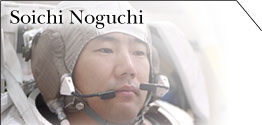 |
 |
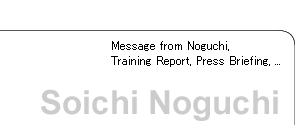 |
|
|
Astronaut Noguchi's Training Report, #13
|
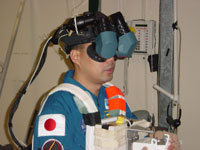 |
| Astronaut Noguchi's SAFER training at a Virtual Realty Lab |
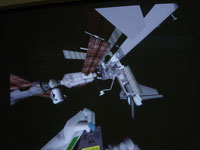 |
| Using Virtual Realty |
ied Aid For Eva Rescue" or SAFER. SAFER is used so that the astronauts can return to the ISS in case of any emergency. It is physically impossible to actually use the SAFER in training: Therefore, Virtual Realty is used for SAFER training.
The development of on-orbit inspection methods for Thermal Protection System (TPS) is underway. One basic method under consideration is to attach a boom on to the Shuttle's robot arm. A sensor attached to the end of the boom is used to inspect the entire vehicle. Another consideration, if problems occur while using the boom method, is the astronauts to conduct an EVA and use SAFER to inspect the vehicle with a camera.
Astronaut Noguchi has already completed standard SAFER training, and Thermal Protection System inspection training.
EVA training at the Neutral Buoyancy Laboratory (NBL)
 |
Explanation of the EVA by Astronaut Noguchi |
| Real Video [1min 39sec] |
Refresher training for replacing the Control Moment Gyro (CMG), which controls the orientation of the ISS, installing the External Stowage Platform-2 (ESP-2), and the Materials ISS Experiment (MISSE) was conducted at the Neutral Buoyancy laboratory (NBL).
The training has been conducted a number of times, but this time "Cross training" was also conducted with the EVA crew member 1 (EV1) and the EVA crew member 2 (EV2) exchanging their roles and performing their partner's training tasks. This is what Astronaut Stephen Robinson and Astronaut Soichi Noguchi did. The purpose of this "cross training" is to gain a new understanding of the other astronaut’s tasks by observing the operation from the other EVA crew member’s perspective. In addition, this enables the EVA crew member, to fully understand the crew member’s role and enable him to continue in the event of any emergency or changes to planned procedures.
Training in the Shuttle Mission Simulator (SMS)
The Shuttle Mission Simulator (SMS) is used for launch, landing and on-orbit operations training. The SMS is located at the Johnson Space Center (JSC). There are two types of SMS. The first is the moving Motion Base (MB) and the second is the stationary Fixed Base (FB). SMS-MB is used for launch and landing training. The cockpit moves vertically from the ground and accurately simulates the jarring motion experienced during launch and position during landing. SMS-FB is primarily used for training of on-orbit operation but can also be used for launch and landing training.
 Post Insertion training in SMS-FB
Post Insertion training in SMS-FB
 |
Explanation of the Post Insertion training by Astronaut Noguchi |
| Real Video [1min 21sec] |
Immediately upon separation of the External Tank (ET), still imagery of the tank will be taken by Astronaut Andrew Thomas while video imagery will be taken by Astronaut Soichi Noguchi. This SMS-FB simulation covers the tasks from the collection of the images to the tasks planned upon achieving orbit.
For the first 8min and 30 sec after launch, the Shuttle is accelerated by engines in a "rocket" mode. After that, the Shuttle becomes a "space ship". In order for the astronauts to perform their required operations in the "spaceship," the flight deck and middeck must be rearranged. This training is for the deck’s rearrangement.
This training was conducted with the assumption that some trouble had occurred during the regular timeline. The crew members were not aware of what type of trouble would occur. Hence, they are trained to resolve any system difficulty while following the planned timeline. As the launch date approaches, Post Insertion training will continue including wearing flight suits, at the full-scale shuttle training facility.
 De-orbit preparation training in the SMS-FB
De-orbit preparation training in the SMS-FB
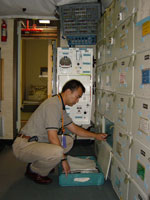 |
| Astronauts Noguchi during de-orbit preparation training in the SMS-FB |
In addition to Post-Insertion training, de-orbit preparation training was also conducted in the SMS-FB. In order for a shuttle to return to the Earth from orbit, the "spaceship" must be reconfigured to become a "glider" . First, the opened Payload Bay Doors must be closed and an adjustment of the shuttle's course for de-orbiting must be made. The galley and restroom on board the "spaceship", and all other equipment must be deactivated while preparing for re-entry. This includes donning suits and getting back into their respective seats. This entire process is simulated with the participation of all seven crew members.
Astronaut Noguchi's Comment
The first de-orbiting training was completed using the FB after the three new crew members had joined. Before the Columbia Accident, we were supposed to support the returning expedition crews from the ISS along with the regular preparation for returning. The addition of the three new crew members clarified each member's role in the process and enabled us to simulate the roles more technically.
 Launch simulation using the SMS-MB
Launch simulation using the SMS-MB
The simulation using the SMS-MB has been completed many times; however this was the first STS-114 specific simulation to be conducted after the Columbia accident.
Launch simulation is not just for regular flight tasks. It is also conducted to train the crew members to cooperate with each other and to bring the Shuttle safely back even if several important components, such as the main engines, fail at once. NASA considers "Space Flight Resource Management: SFRM" or the effective utilization of each crew member's ability to be very important. This training is repeated again and again so that, if multiple mishaps occur the crew members can work as a team by clearly understanding each individual’s roles.
